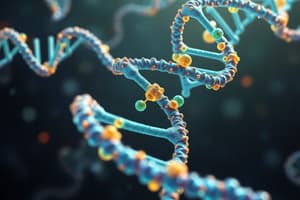Podcast
Questions and Answers
What distinguishes genetic RNA from non-genetic RNA?
What distinguishes genetic RNA from non-genetic RNA?
- Genetic RNA is mainly involved in the synthesis of proteins.
- Genetic RNA is present in most organisms, while non-genetic RNA is present in a few.
- Genetic RNA only exists in ribonucleotide form.
- Genetic RNA is essential for heredity, whereas non-genetic RNA is not. (correct)
Which of the following correctly identifies a component of ribonucleotides?
Which of the following correctly identifies a component of ribonucleotides?
- Thymine base
- Amino acids
- Uracil base (correct)
- Deoxyribose sugar
Which function is associated with non-genetic RNA?
Which function is associated with non-genetic RNA?
- Formation of ribonucleotides
- Protein synthesis (correct)
- Transport of genetic material
- Involvement in heredity
What is a characteristic feature of m-RNA?
What is a characteristic feature of m-RNA?
Which type of RNA is primarily responsible for transporting amino acids during protein synthesis?
Which type of RNA is primarily responsible for transporting amino acids during protein synthesis?
Who initially discovered the substance now known as nucleic acid?
Who initially discovered the substance now known as nucleic acid?
What key component did Richard Altmann identify as being abundant in nucleic acids?
What key component did Richard Altmann identify as being abundant in nucleic acids?
Which of the following elements is NOT a component of nucleic acids as identified by Richard Altmann?
Which of the following elements is NOT a component of nucleic acids as identified by Richard Altmann?
What was the original name given to nucleic acid when it was discovered?
What was the original name given to nucleic acid when it was discovered?
What combination of elements did Richard Altmann find to comprise nucleic acid?
What combination of elements did Richard Altmann find to comprise nucleic acid?
Which of the following accurately describes genetic RNA?
Which of the following accurately describes genetic RNA?
What distinguishes non-genetic RNA from genetic RNA?
What distinguishes non-genetic RNA from genetic RNA?
Which type of RNA is primarily responsible for carrying genetic instructions from DNA to ribosomes?
Which type of RNA is primarily responsible for carrying genetic instructions from DNA to ribosomes?
Which statement is true regarding r-RNA?
Which statement is true regarding r-RNA?
What is the primary function of t-RNA during protein synthesis?
What is the primary function of t-RNA during protein synthesis?
What percentage of total RNA is composed of m-RNA?
What percentage of total RNA is composed of m-RNA?
Which of the following correctly describes the structure of RNA?
Which of the following correctly describes the structure of RNA?
In which scenario is genetic RNA primarily found?
In which scenario is genetic RNA primarily found?
What is the primary function of m-RNA within the cell?
What is the primary function of m-RNA within the cell?
Which component of a nucleotide is responsible for the nucleic acid's classification as DNA or RNA?
Which component of a nucleotide is responsible for the nucleic acid's classification as DNA or RNA?
What distinguishes non-genetic RNA from genetic RNA in an organism?
What distinguishes non-genetic RNA from genetic RNA in an organism?
Which statement accurately describes the structure of RNA?
Which statement accurately describes the structure of RNA?
What role does the pentose sugar in a nucleoside play?
What role does the pentose sugar in a nucleoside play?
Flashcards are hidden until you start studying
Study Notes
Nucleic Acids Overview
- Two main types of nucleic acids in living cells: DNA and RNA.
- Nucleotides are the building blocks of nucleic acids, consisting of a nucleoside and phosphoric acid.
- Nucleosides contain a pentose sugar and nitrogenous bases.
- Nucleic acids are crucial for determining the physiological and biological properties of organisms.
RNA (Ribonucleic Acid)
- Comprises ribose nucleic acid, prevalent in most organisms.
- Located in both the nucleus and cytoplasm of cells.
- Can be single-stranded or double-stranded.
- Ribonucleotides are formed from ribose sugar, nitrogenous bases (Adenine, Guanine, Uracil, Cytosine), and phosphoric acid.
Types of RNA
- RNA categorized by function into genetic and non-genetic types.
Genetic RNA
- Found in only a few microorganisms.
- Plays a role in heredity and transfers parental traits to offspring.
- Capable of replication, facilitating the transfer of genetic information in cells without DNA present.
Non-Genetic RNA
- Present in most organisms, primarily involved in protein synthesis.
- Lacks the ability to replicate.
- Derived from DNA and exists in association with it.
Detailed Types of Non-Genetic RNA
m-RNA (Messenger RNA)
- Represents approximately 5-10% of total RNA.
- Acts as a messenger by transmitting instructions from DNA to ribosomes.
- Derived from DNA through transcription.
- Contains both codons and non-codons; codons activate ribosomes for protein formation.
- Does not carry genetic information nor contributes to termination of protein synthesis.
t-RNA (Transfer RNA)
- Also makes up about 5-10% of total RNA.
- Found in the cytoplasm, activates amino acids for ribosome incorporation.
- Each t-RNA molecule is specific to a codon on the mRNA.
- Plays a critical role in arranging sequences during translation.
r-RNA (Ribosomal RNA)
- Accounts for roughly 80% of total RNA.
- Key component of ribosomes, crucial for protein synthesis.
- Facilitates the synthesis of peptide bonds between adjacent amino acids.
- Assists in releasing m-RNA during the protein assembly process.
Historical Context
- Friedrich Miescher discovered an acidic substance in the nucleus, naming it nuclein.
- Richard Altmann noted its phosphorus-rich composition and termed it nucleic acids.
- Leven identified two nucleic acid types in living cells: DNA and RNA, which are polymers of nucleotides.
Studying That Suits You
Use AI to generate personalized quizzes and flashcards to suit your learning preferences.




